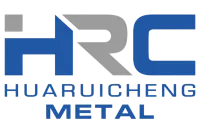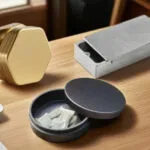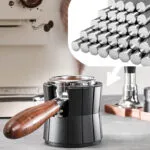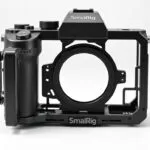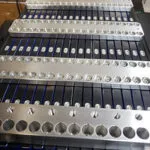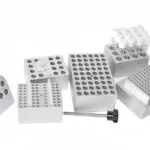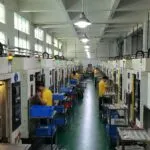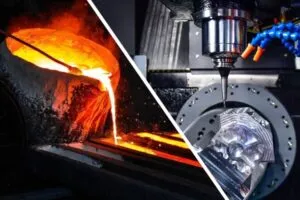Anodized aluminum is gaining popularity in kitchens for its durability and resistance to corrosion. This process makes aluminum look better and last longer. But, is it safe for food contact?
We will look into the safety of anodized aluminum for food use. We’ll discuss health concerns and standards for safe materials. We’ll also cover its benefits, like resisting scratches and tarnish, and its use in CNC machining.
What Is Anodized Aluminum?
Anodized aluminum is aluminum that has been treated with a special electrochemical process called aluminum anodizing. This process makes the aluminum’s surface layer thicker. It also makes the aluminum more resistant to corrosion.
The anodizing process not only strengthens the metal. It also lets us add different colors and finishes. This makes anodized aluminum very popular in many industries.
The properties of anodized aluminum make it great for things like kitchenware, car parts, and even space components. It’s durable and looks vibrant. Plus, the anodized layer doesn’t react with food, which is perfect for cooking and storing food.

In short, anodized aluminum lasts longer and looks better than regular aluminum. Its ability to be both strong and stylish has made it a favorite in modern manufacturing.
The Anodizing Process Explained
The anodizing process has several key stages that make aluminum better for many uses. It makes the metal last longer, resist corrosion, and look better. Knowing these stages helps pick the best method for each need.
Stages Of The Anodizing Process
The anodizing process includes cleaning, anodizing, dyeing (if needed), and sealing. Each step is crucial for the final look and function of the anodized surface:
- Pre-treatment: Cleaning the surface ensures the anodizing works well.
- Anodizing: The aluminum is oxidized in a special bath, creating a protective layer.
- Dyeing: If wanted, coloring can be added to match specific looks without harming the anodized layer.
- Sealing: This step makes the anodized surface even more durable by blocking pores and protecting it from the environment.
Types Of Anodizing
There are different anodizing types for different uses. Some notable ones are:
- Type I: Chemical anodizing uses chromic acid for better corrosion protection.
- Type II: Sulfuric acid anodizing is popular for its mix of color and protection.
- Type III: Hard anodizing creates a thick layer for more durability and resistance to wear.

Is Anodized Aluminum Safe for Everyday Use?
The safety of anodized aluminum is a big concern, especially in cookware and kitchen tools. This method makes aluminum last longer and look good. People often ask if it’s safe for food.
Many studies and groups have checked if anodized aluminum is safe for food. They found it’s okay to use with food. This is because the anodized layer doesn’t release harmful stuff. So, it’s safe for cooking at home.
But, it’s important to be careful with some anodized aluminum products. Some colors or coatings might not be safe. Always choose well-known brands and check their safety labels. Good kitchen brands tell you about their materials and how they make them.
In short, anodized aluminum is a great choice for daily use, especially in cooking. It’s durable and safe for food. This makes it perfect for what we need in our kitchens.
How Does Anodized Aluminum Compare to Stainless Steel?
Choosing between anodized aluminum and stainless steel for kitchenware involves looking at their pros and cons. We’ll explore how they compare in terms of corrosion resistance, upkeep, weight, and cost.
Anodized aluminum is great at resisting corrosion thanks to its protective layer. This makes it last longer than regular aluminum, perfect for everyday kitchen use.
Stainless steel, on the other hand, is strong and less likely to rust. It’s a good choice for kitchens with lots of moisture. Both materials are safe for food, without releasing harmful substances.
Maintenance is another key difference. Anodized aluminum is easy to keep clean because it doesn’t scratch or stain easily. Stainless steel, however, needs more cleaning to stay looking good, especially if it gets fingerprints and water spots.
Weight is also important. Anodized aluminum is lighter, making it easier to handle during cooking. Stainless steel, being heavier, is more durable.
Cost is a factor too. Anodized aluminum is generally cheaper than stainless steel. This makes it a good option for those on a budget who still want quality cookware.
| Feature | Anodized Aluminum | Stainless Steel |
|---|---|---|
| Corrosion Resistance | High | Very High |
| Maintenance | Low | Moderate |
| Weight | Light | Heavy |
| Cost | Lower | Higher |
| Food Contact Safety | Safe | Safe |
Understanding these differences helps people choose the right material for their kitchenware. It’s all about finding what fits their needs best.
Can Anodized Aluminum Wear Off?
Anodized aluminum is known for its great durability. But, different things can affect how long its anodized layer lasts. The main issue is how you clean these surfaces.
Using rough cleaners or harsh chemicals can really hurt the anodized layer. This can cause it to wear off faster.
Also, rubbing against other materials can slowly wear down the anodized finish. This can change how well the product works and looks. How long the anodized finish lasts depends on a few things.
These include how thick the anodized layer is and where the aluminum is used.
Compared to other materials, anodized aluminum lasts longer. Taking good care of it, like using gentle cleaners and soft cloths, can help it last even longer. Knowing how to take care of anodized surfaces helps both buyers and makers make better choices.
How Do You Clean Anodized Aluminum Products?
Cleaning anodized aluminum needs special techniques to keep it looking good and lasting long. Regular care is key to keeping your anodized aluminum in top shape. Follow these maintenance tips to make sure your anodized aluminum stays beautiful.
Begin with simple cleaning solutions. A warm water and dish soap mix is great for light cleaning. Use a soft cloth or sponge to gently wipe the surface. For harder stains or dirt, try a water and baking soda mix with a non-abrasive pad.
Stay away from harsh chemicals, vinegar, and abrasive cleaners. They can harm the anodized layer, causing color changes or damage. After cleaning, rinse well with clean water to remove soap. This prevents spots or streaks from forming.
| Cleaning Agent | Application | Pros | Cons |
|---|---|---|---|
| Warm soapy water | Apply with a soft cloth | Gentle and safe | May not remove heavy stains |
| Baking soda paste | Gently scrub with a soft pad | Effective on stubborn stains | Requires rubbing |
| Commercial aluminum cleaner | Follow manufacturer’s instructions | Designed specifically for aluminum | Cost can be higher |
Following these tips for cleaning anodized aluminum helps keep your products looking and working great. With proper anodized aluminum care, you can enjoy your items for many years. Regular cleaning boosts their performance and looks.
Can Anodized Aluminum Be Recycled?
Anodized aluminum recycling is a bit tricky. The protective anodized layer makes it harder to recycle than regular aluminum. But, recycling it still helps the environment a lot.
Recycling anodized aluminum is good for the planet. It’s part of using more sustainable materials. Recycling aluminum keeps it in top shape, which is great for companies that care about the environment.
Recycling is key in managing waste. Many places can recycle aluminum, including anodized types. But, it’s smart to check with your local recycling program first. Recycling anodized aluminum helps create a more circular economy in the metal world.
| Aspect | Regular Aluminum | Anodized Aluminum |
|---|---|---|
| Recyclability | Widely accepted | Accepted but requires specific processing |
| Impact on Environment | Reduces waste and energy consumption | Reduces waste, supports eco-friendly options |
| Processing Difficulty | Less complex | More complex due to anodized layer |
How Does Anodizing Affect the Weight of Aluminum Parts?
Anodizing adds a protective layer to aluminum parts, which is crucial in industries like aerospace and automotive. This process only slightly increases the weight of the aluminum. Despite this, the benefits of durability and corrosion resistance make anodized aluminum a top choice for many.
For those in CNC machining, knowing about aluminum parts is key. Anodized aluminum is both light and strong, perfect for where precision and weight matter. The extra weight from anodizing is usually factored into design specs, ensuring parts work well and last longer.
In summary, anodizing may slightly increase the weight of aluminum parts. Yet, the benefits of longer life and better protection are well worth it. This makes anodized CNC aluminum parts a go-to for industries where performance and reliability are essential.
